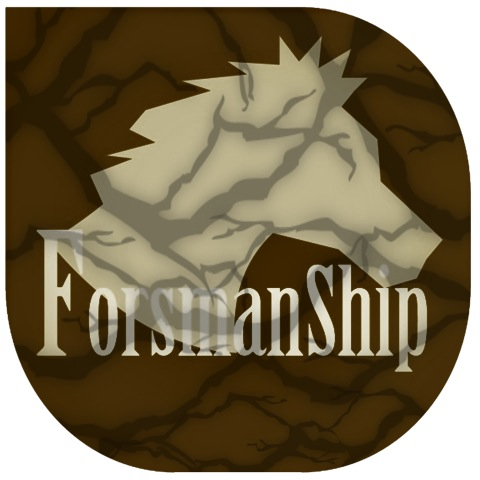
Horseman Forsman
It takes the time it takes …
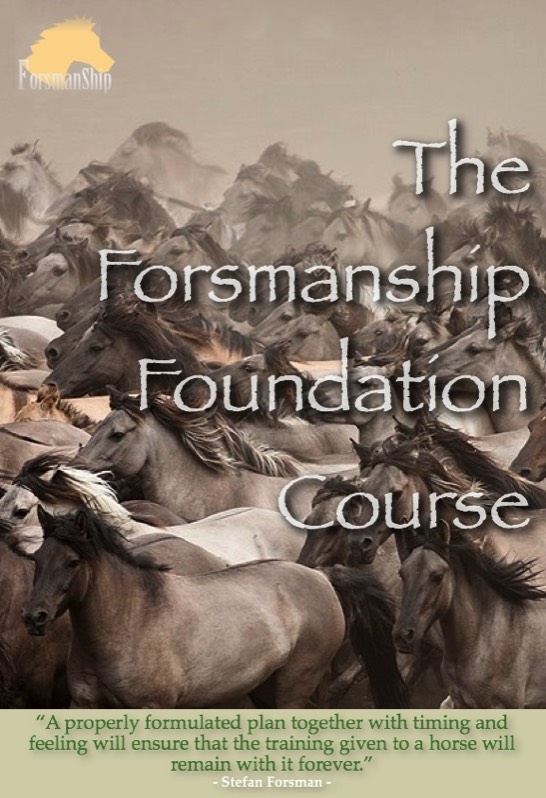

INTRODUCTION:
The Forsmanship Foundation Course
The Forsmanship Foundation Course
A properly formulated plan together with timing and feeling will ensure that the training given to a horse will remain with it forever.
Stefan Forsman
Welcome to the Forsmanship Foundation Program. Over the course of six days you will receive a substantial education by one of the founders of natural horsemanship in the world. Stefan Forsman is world class in this field - un-equalled in this part of the world.
He has the knowledge and the experience that will benefit you and your horse for years to come. Training with Stefan will mark the beginning of a new chapter in your life and prepare the way for you to rise above being an average horse person, to becoming a great horse communicator - plus a happier and more successful person yourself.
Learn a new system of training that will provide a sustainable and rewarding relationship with your horse, a safer, happier and more co-operative horse, and a vast improvement in how you work and play together - whether riding in the forest, beside highways, through busy, city streets or in the competition arena.
Understand why it is important in natural horsemanship to look at YOUR behaviours FIRST. Learn why it is critical to develop good leadership skills and to have clear and consistent communications with your horse at all times - and especially if your horse has developed serious, behavioural problems.
He has the knowledge and the experience that will benefit you and your horse for years to come. Training with Stefan will mark the beginning of a new chapter in your life and prepare the way for you to rise above being an average horse person, to becoming a great horse communicator - plus a happier and more successful person yourself.
Learn a new system of training that will provide a sustainable and rewarding relationship with your horse, a safer, happier and more co-operative horse, and a vast improvement in how you work and play together - whether riding in the forest, beside highways, through busy, city streets or in the competition arena.
Understand why it is important in natural horsemanship to look at YOUR behaviours FIRST. Learn why it is critical to develop good leadership skills and to have clear and consistent communications with your horse at all times - and especially if your horse has developed serious, behavioural problems.
The fault is always with the owner - never the horse!
Everything is training. Every minute, every second you spend with a horse you are training them, because they will be affected by you in either a positive or negative way.
Therefore, I consider horses wrongly trained (or not trained properly) that will not stand still, that nudge, nip and even bite, will not be loaded into a horse box, bolt as soon as they become afraid, that tug at the reins, grab the bit, and buck and rear. Some say that such horses are spirited and happy - I believe this to be the exact opposite. It is a nervous horse that is unaware of its limits, what rules apply, or whom it should trust.
Stefan Forsman
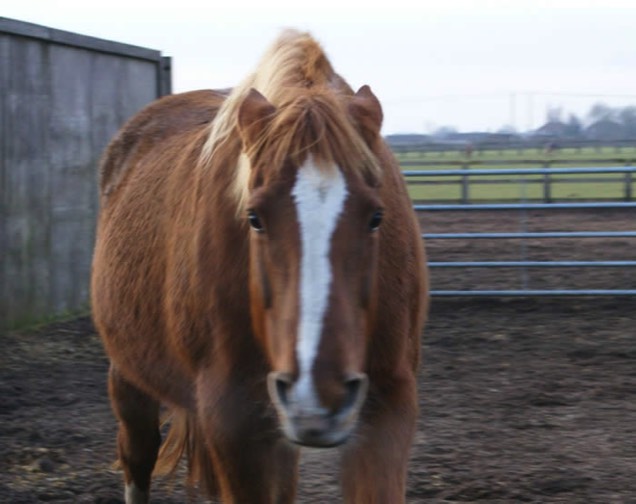
Photo from Redwings Horse Sanctuary in the UK .. rehabilitating abused horses
It is important for horse owners to understand who they are, what they radiate, how they behave - because that is the horse they will get.
A well behaved and co-operative horse who will follow you without a lead rope and halter, one which can be ridden without a head stall and reins, who will lie down for you and rest on the grass and stay there for as along as you need them to - that is a horse that trusts its owner and looks to him as a leader.
Stefan Forsman
Recognise and let go of existing, more traditional ideas of horse training and care that do not serve the horse, or you.
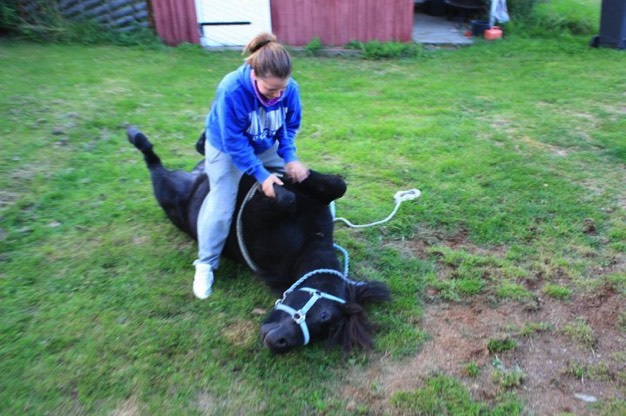
This owner in Norway has established a trusting and loving relationship with her pony after raising it with Forsmanship methods.
''In Sweden, a lot of horses develop such serious behavioral problems that people can't really do anything with them. A lot of them end up going from owner to owner, from trainer to trainer. I read somewhere that 85% of all Swedish horses never make it. The reason why they don't make it is the conventional, traditional training. The horses simply go mad. I don't know if 85% is a correct figure, but I do know for a fact that a lot of them have severe problems.''
Stefan Forsman

I tried the conventional, traditional, normal, way of training horses for quite some time before I realized that it wasn't working very well ..I understand today that it was not because we were good horseman that we sometimes managed to get a horse into a trailer. It was in spite of us.
Stefan Forsman
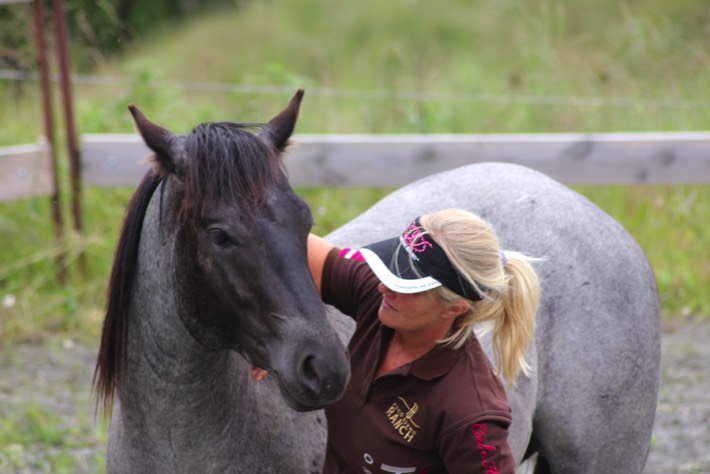
Photo of Bjørg Andreasson Hals training a young horse using Forsmanship methods. Photo by Hanne Kringstad
''A horse that is trained correctly becomes safe, trusting and co-operative. Those who have a thorough knowledge of how the horse thinks, communicates and behaves, and then puts this into practice will obtain results in the form of horses that are safe, unafraid and, in addition, co-operative.''
Stefan Forsman
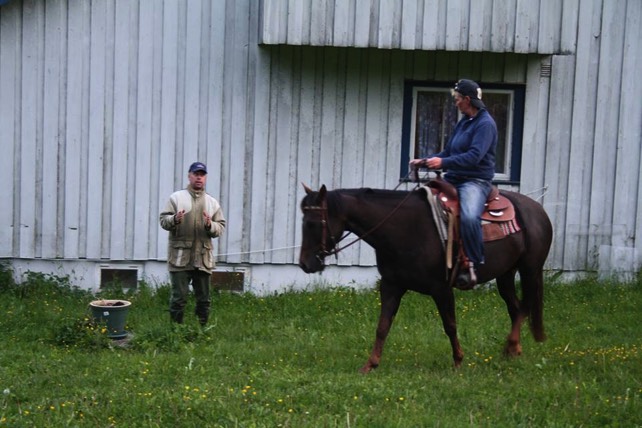
Stefan instructs a rider in Norway on some important differences between traditional horse training methods and Forsmanship.
''When I am asked how long the training takes my reply is always the same "It takes the time it takes, because if you take the time it takes today it will not take any time at all in the future." I believe it better to take the time and effort to get the horse well behaved, calm and reliable so that harsh aids such as sharp bits, draw reins, whips, bound tongues, etc., do not have to be used.''
Stefan Forsman
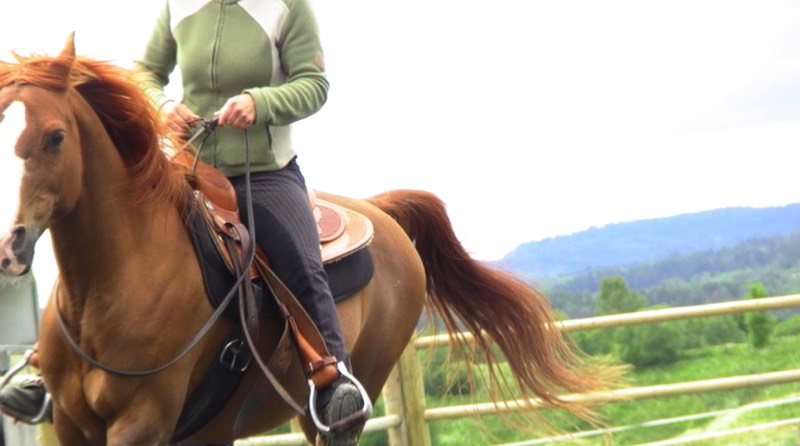
Bjørg Andreasson Hals demonstrates the fruits of Forsmanship with her champion arab Zantos. Interview with Bjørg HERE
A properly formulated plan together with timing and feeling will ensure that the training given to a horse will remain with it forever.
Stefan Forsman
Understand what a horse needs, how it has evolved, it’s natural instinctual behaviors and how it thinks - then understand how this translates and is applied into the Forsmanship system of training.
Stefan Forsman
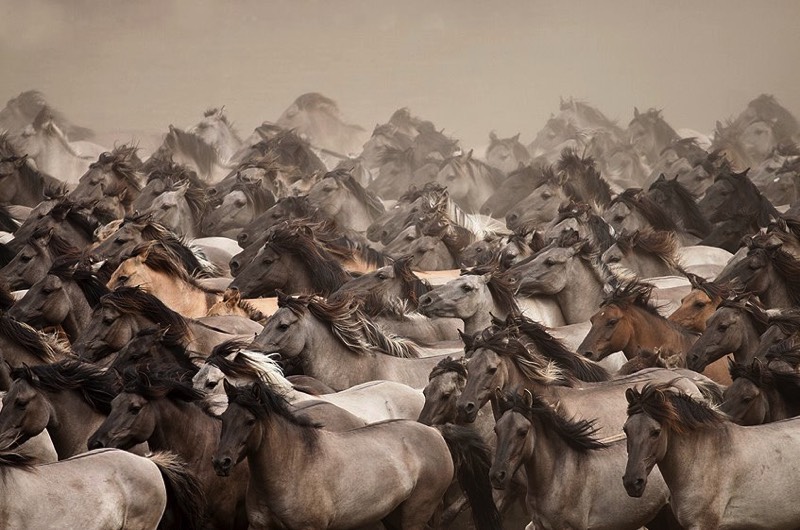
Wild Horses by Stefanie Lategahn
''The horse is a herd animal whose first form of defense is flight. In the wild the herd always has a leader to which it always looks to see whether flight is necessary or not .. ''
Stefan Forsman
'' When man removes the horse from the herd he takes away the horse's natural leader, thereby making him wary and unsure. Depending on character and past experiences the horse will become, to a greater or lesser extent, nervous...
If man can communicate with the horse in the only way the horse understands - using body language - that he is taking over the role of leader, then the horse can once again relax and flight no longer becomes necessary. ''
Stefan Forsman

So, as long as man (using his body) can communicate that everything is as it should be, then the horse will remain calm and relaxed.
Stefan Forsman

THEORY - the first 3 days
Absolutely essential and mandatoryto progress into the following
(practical) 3 days of training.
It starts you on the pathway to true natural horsemanship and this journey begins with you.
Human behaviour is absolutely criticial to understand. This is because who you are is how your horse behaves and performs.
Over this 3 days, you will be challenged to look at what YOU need to develop in yourself to get the best results from your horse:
- to improve the core relationship with your horse
- to develop better and safer behaviours in your horse
- to create a happier horse
- to improve the performance edge you might want to achieve with your horse in competition.

Delivered over the 3 days:
Leadership and the right mental attitude
This is the most important part of preparatory training in Forsmanship. For you as a person and for your horse to feel safe and confident in you as a leader. Your behaviour and your mental attitude are critical because:
- What you think is what you radiate
- Things will always turn out the way you think they will.
- You might have a lot of knowledge in your tool box, but if you don’t have the right mental mindset, then you will be just the same average horse person out there.
- Understanding this and taking responsibility for who you are in the relationship dynamic with your horse is the bottom line and cannot be overlooked.
Believing in yourself, moving your boundaries, moving out of your own comfort zone, becoming a leader and a winner.
This is critical in order to achieve the results that you want - long lasting and sustainable results.
- Who are you in life at the moment?
- What are your attitudes and behaviours and how have you developed them?
- What kind of energy do you send off?
- What is your body language and voice saying?
- What do you need to do to overcome any weaknesses that you have as a communicator?
- Understand how all this translates into how you relate and communicate with your horse.
Without knowing this, you cannot possibly advance to excel in horsemanship.
As long as you do what you have always done, you will always get the same results. If you want something you have never had before, you have to do something you have never done before
Stefan Forsman

Maria Klausen, from Norway, demonstrates how Forsmanship has helped her develop a very trusting relationship with horses.
Understanding horses
As you begin to understand yourself better, Stefan also integrates knowledge about horses, in all areas:
- How they have evolved.
- How they think.
- Why they do what they do, reasons for their natural instincts and behavours because there is a reason for everything they do.
- How a horse senses and learns.
Learning about a horse´s needs
Further knowledge building to meet the humane needs of your horse:
- Understand what it is that a horse needs.
- Understand what satisfies a horse in body and mind.
- Learn tips on how to take good care of your horse.
Combining what you know about a horse and now learning how to work with nature
Students are prepared to understand the importance of the delicate relationship that needs to be nurtured between them and their horse:
- How to work with nature, instead of working against it, as has been the ‘norm’ in more traditional forms of animal training.
▪ How to translate this into practical work with your horse
▪ How to get the respect of your horse
▪ How to take a horse - from just tolerating you - to truthfully loving you, wanting to follow you, even without a lead rope and halter, even prepared to walk through fire to follow you
▪ Understand how if this is done correctly, how the Forsmanship system will work on any horse, on any breed, be it a stallion, a mare or a gelding.
▪ Understand how working with nature will work every time.

PRACTICAL - the second 3 days
Creating safer, trusting,
more dependable and
co-operative horses
- Learn new techniques
- Apply Forsmanship theory
- Experience and witness the positive development of horses and humans, using the Forsmanship mind set and methods
Supervised practice begins in earnest during this 3 days and new knowledge of Forsmanship techniques in action are delivered, proving how Forsmanship works to produce fantastic results.
Students observe Stefan Forsman demonstrate the Forsmanship system of handling and training. Students watch and learn new techniques, which create safer and more dependable horses, a more harmonious and trusting, working relationship between animal and human, applying the basic elements of:
*Leadership
*Consistency and,
*Comfort Zone
Read further below, see Stefan’s definition of these terms in the article titled: SAFE AND DEPENDABLE HORSES NOT DIFFICULT TO OBTAIN
Integrated between demonstrations, students together with their horses, or working with horses owned by others, are provided with excellent opportunities over the 3 days to practice Forsmanship techniques and develop the skills required to apply the foundations of Forsmanship theory, given during the first 3 days of the course.
This time is valuable to experience and also to observe and learn through the practice of others in their progression through the Forsmanship principles.
Students observe Stefan Forsman demonstrate the Forsmanship system of handling and training. Students watch and learn new techniques, which create safer and more dependable horses, a more harmonious and trusting, working relationship between animal and human, applying the basic elements of:
*Leadership
*Consistency and,
*Comfort Zone
Read further below, see Stefan’s definition of these terms in the article titled: SAFE AND DEPENDABLE HORSES NOT DIFFICULT TO OBTAIN
Integrated between demonstrations, students together with their horses, or working with horses owned by others, are provided with excellent opportunities over the 3 days to practice Forsmanship techniques and develop the skills required to apply the foundations of Forsmanship theory, given during the first 3 days of the course.
This time is valuable to experience and also to observe and learn through the practice of others in their progression through the Forsmanship principles.
I have seen people change their attitude
completely to horses after working with
Stefan Forsman's guidance. I continue to seek his
advice …there is something more he gives every
time … his knowledge does not stand still,
it truly grows
Katerina Persson

Sara Lind and her horse Sharo begin a day with Stefan and Forsmanship training.
Delivered over the 3 days:
*Integrating and applying the basic elements and principles behind the Forsmanship system of Leadership, Consistency and Comfort Zone.
*Observing how the system of techniques will take a horse with behavioural problems (nervous, flighty, stubborn, unpredicatable and generally unsafe to be around) to a horse who can remain calm and relaxed in all situations you put him in.
*Witnessing how a horse can develop from being led with a lead rope and halter, to following without - happily and willingly - and at a safe distance.
*Observing how the system of techniques will take a horse with behavioural problems (nervous, flighty, stubborn, unpredicatable and generally unsafe to be around) to a horse who can remain calm and relaxed in all situations you put him in.
*Witnessing how a horse can develop from being led with a lead rope and halter, to following without - happily and willingly - and at a safe distance.
*Observing and practicing the system of techniques of handling horses in stables.
*Observing and practicing the system of techniques of training horses in the round pen.
*Observing and practicing the system of techniques of handling horses for transportation - into and out of horse trailers.
BENEFITS OF THE PRACTICAL PROGRAM
- Development and awareness of personal leadership qualities in training and communicating with horses.
- Increased personal awareness of the effects of intention in animal work and personal energy projection.
- Greater understanding and awareness of the importance of being consistent and of facilitating a comfort zone for horses in their care and training.
- Expanded knowledge and understanding of how crucial all these elements are in horse care and raising:
1. to correct problems
2. to develop a more balanced and harmonious relationship with horses
3. to improve your performance together in riding - whether it be for pleasure or competition.

IMPORTANT NOTICE
NO SPECTATORS AT THIS COURSE, PARTICIPANTS ONLY
Please note: we do not allow outside spectators who just wish to view a practical component of Forsmanship training to stand on the sidelines and watch activities.
We need to be very clear about this. Forsmanship training is not a dog a pony show, it is about intensive and serious engagement for you and your horse. We would not have it any other way.
We therefore cannot have outsiders who are not prepared and properly informed by the theoretical component of Forsmanship training, spectating and judging what they see from the sidelines because they simply are not informed enough to watch in the context of the whole training approach.
We need to be very clear about this. Forsmanship training is not a dog a pony show, it is about intensive and serious engagement for you and your horse. We would not have it any other way.
We therefore cannot have outsiders who are not prepared and properly informed by the theoretical component of Forsmanship training, spectating and judging what they see from the sidelines because they simply are not informed enough to watch in the context of the whole training approach.
Price of Forsmanship Foundation Course includes:
- Six full days of knowledge building, experience and teaching from one of the founders of Natural Horsemanship.3 days of intensive theory and groundwork to the philosophy, principles and techniques of Forsmanship methodology.
- 3 days of demonstrations of key Forsmanship training and caring techniques, integrated with applied practice periods to experience Forsmanship training yourself, under the supervision and instruction of Stefan Forsman.
• Access to and use of training venue facilities (not including stable costs and horse feed if bringing your horse)
• 2 fikas every day of the course (you are expected to bring your own lunches, however if you would like to be catered for, this can be arranged as an extra cost*)
*Extra Costs
- If you would like other meals catered for during the six days, we will organise this for you at a reasonable rate. Please enquire further with the course arranger.
• If you require accomodation close to the course, this can be arranged for an extra cost, enquire with the course arranger (nearby hostels, hotels can also be recommended upon request).
• If you require your horse to be stabled during the practical, the course arranger will help you with this too.
Course arranger Nittedal, Norway:
Hilde Marie Lind
Course arranger Norra Bohuslän, Sweden:
Ann-Sophie Granholm
Course arranger Eggedal, Norway:
Elisabeth Koren Bøle
Course arranger Hallabro, Ronneby, Sweden:
Therese Johansson
Course arranger Karlskrona, Sweden:
Anna-Karin & Peter Hagdahl
Course arranger Aurskog, Norway:
Hanne Kringstad
Course arranger Holen Ranch, Norway:
Bjørg Andreasson Hals
Course arranger Telemark, Norway:
Stine Langen
Course arranger Pöytä, Finland:
Terhi Rasinperä
Course arranger Løten, Norway:
Siv Hornsletten (mail)

Additional notes from Stefan Forsman
(first published in the Horse Previews Magazine)
(first published in the Horse Previews Magazine)
I was born in Sweden in 1962. I grew up in a small village with all kinds of animals. Horses, cows, sheep, chickens, etc. I was always fooling around with animals, especially horses. When I was 14 years old, other people started sending horses to me for training. I tried the conventional, traditional, normal, way of training horses for quite some time before I realized that it wasn't working very well. Sure I could get some old, crazy trotter or riding horse to slow down a bit by putting a sharper bit in their mouth's, but the horses sure weren't relaxed and they didn't travel at a slow pace for very long. They soon became immune to the sharper bit, too. Off course that was not the only problem I had, they were bucking, rearing, kicking, biting, running away, refusing to load in trailers. Well, you name it.
I understand today that it was not because we were good horseman that we sometimes managed to get a horse into a trailer. It was in spite of us. We thought we were really good with horses. I used to ask people a lot of questions in the seventies (still do). Like, why are you doing that? Why are you using that equipment? The answer was always the same (still is). We've always done it this way. My reply was (still is), yes, but I want to know why. Well, if I got an answer, it was that they where trying to force the horse with some kind of gimmick, to do what they wanted. My reply was (still is), well it doesn't work. Well we know that, but it has always been done this way and everybody else is doing the same thing. That was the answer I got back then and that is the answer I get today. Just because everybody else is doing something doesn't necessary mean that it's right. In Sweden, a lot of horses develop such serious behavioral problems that people can't really do anything with them. A lot of them end up going from owner to owner, from trainer to trainer. I read somewhere that 85% of all Swedish horses never make it. The reason why they don't make it is the conventional, traditional training. The horses simply go mad. I don't know if 85% is a correct figure, but I do know for a fact that a lot of them have severe problems.
Some people will say that the reason why a lot of the horses never make it is that they break down. Yes I know that too, a lot of them become lame, etc. But why are so many horses going lame? Well, one reason is that many horses are always tense, stiff, and nervous. The horses are also working with their bodies or body parts in the wrong position. This puts a lot of strain on the horses who, in turn, become lame as a result. Another contributory factor to why so many horses are getting hurt, and for that reason can't be ridden or driven, is that they are totally out of control. They run blindly into things, throw themselves backwards in panic when tied up or loaded onto a trailer. The ones that make it sure aren't without problems. The problems just aren't that severe, yet. They jump fences, run races, pull carts etc., etc. in spite of the handling (training) they get. I've always had my own ideas about things and especially horses (animals). I'm very particular about everything I do and especially when it comes to my horses. I've always wanted everything to be perfect and the way I want it. People have a tendency to make things so darn complicated when it actually is very simple.
SAFE AND DEPENDABLE HORSES
NOT DIFFICULT TO OBTAIN
A horse that is trained correctly becomes safe, trusting and co-operative. Those who have a thorough knowledge of how the horse thinks, communicates and behaves, and then puts this into practice will obtain results in the form of horses that are safe, unafraid and, in addition, co-operative. It is taken for granted that a dog should be trained for both its own and its owner's benefit. For some strange reason this is seldom the case when it comes to horses. I regard as untrained, horses that will not stand still, that nudge, nip and even bite, will not be loaded into a horse box, bolt as soon as they become afraid, that tug at the reins, grab the bit, and buck and rear. Some say that such horses are spirited and happy - I believe this to be the exact opposite. It is a nervous horse that is unaware of its limits, what rules apply, or whom it should trust.
A properly formulated plan together with timing and feeling will ensure that the training given to a horse will remain with it forever. When I am asked how long the training takes my reply is always the same "It takes the time it takes, because if you take the time it takes today it will not take any time at all in the future." I believe it better to take the time and effort to get the horse well behaved, calm and reliable so that harsh aids such as sharp bits, draw reins, whips, bound tongues, etc., do not have to be used. These are often the methods used by owners of "happy and spirited" horses to try and control them. Such horses will in time become increasingly frustrated and dangerous both to themselves and all others around them. It is obvious from their behaviour that the owner is not handling the horse in the correct manner. The fault is always with the owner - never the horse! People often say that they do not have the time to go through with this training. How odd, I think to myself, since they find the time to battle with their horses each and every time they want to load them onto a horse trailer, catch them, shoe them, saddle them, etc.
There are three elements in the basic training of the horse: Leadership, Consistency, Comfort Zone
Leadership
The horse is a herd animal whose first form of defence is flight. In the wild the herd always has a leader, and contrary to popular belief this is an old mare and not a stallion. She is experienced when it comes to grazing, watering holes and predators, and, hence, when and where flight is necessary. Flight always requires energy and if this can be avoided so much the better. The herd always look to the leader to see whether flight is necessary or not. The whole herd has a natural and instinctive respect for the lead mare. When man removes the horse from the herd he takes away the horse's natural leader, thereby making him wary and unsure. Depending on character and past experiences the horse will become, to a greater or lesser extent, nervous. If man can communicate with the horse in the only way the horse understands - using body language - that he is taking over the role of leader, then the horse can once again relax and flight no longer becomes necessary. So, as long as man (using his body) can communicate that everything is as it should be, then the horse will remain calm and relaxed.
Consistency
Only by being 100% consistent in all you do with the horse can it relax totally in your company and know exactly what to expect. Likewise, only by being absolutely consistent can you expect the horse to understand you. After all he does not speak your language - only "horse-body" language! You must teach yourself how to communicate to the horse which rules apply in your relationship. You cannot sometimes allow the horse to nudge you just "a little bit" because it is "nice" and then later become angry because it is nudging you too hard! You cannot let it nibble the sleeve of your jacket one day and then shout at it the next when it bites a piece out of the material. The horse does not understand "degrees" of any kind. Therefore, do not let it nudge, nip or bite you at all - this is both the best and safest approach for you and the horse. If you for example decide that "whoa" means "stop" then it must always only mean "stop" - never, for example, "slow down". Always, on every occasion without exception - however long it may take - every word and every action must mean exactly the same. If you have given the command "whoa", do nothing else until the horse has stopped and stands still. Always!
Comfort Zone
At the split second the horse responds to your stimuli to do or not to do something, stop immediately. This is the reward for a correct response. You stop squeezing, stop kissing, slacken the lead rope or whatever it was you were doing, the same split second and not a moment later. Always be consistent! For example when you pull on the lead rope to make the horse move, at the first indication of movement forwards slacken the rope, at once, every time. Very soon the horse will want to do what you require so that it avoids the tight rope, the pressure from the legs, your kissing, etc. In the end the horse will become so sensitive to your commands that it is virtually enough to "think" about what you are going to do. The horse will feel your thoughts through your body before you have had time to apply any aids.
This is how simple it is in theory to lay the foundation for a perfect relationship between man and horse.
Stefan Forsman
I understand today that it was not because we were good horseman that we sometimes managed to get a horse into a trailer. It was in spite of us. We thought we were really good with horses. I used to ask people a lot of questions in the seventies (still do). Like, why are you doing that? Why are you using that equipment? The answer was always the same (still is). We've always done it this way. My reply was (still is), yes, but I want to know why. Well, if I got an answer, it was that they where trying to force the horse with some kind of gimmick, to do what they wanted. My reply was (still is), well it doesn't work. Well we know that, but it has always been done this way and everybody else is doing the same thing. That was the answer I got back then and that is the answer I get today. Just because everybody else is doing something doesn't necessary mean that it's right. In Sweden, a lot of horses develop such serious behavioral problems that people can't really do anything with them. A lot of them end up going from owner to owner, from trainer to trainer. I read somewhere that 85% of all Swedish horses never make it. The reason why they don't make it is the conventional, traditional training. The horses simply go mad. I don't know if 85% is a correct figure, but I do know for a fact that a lot of them have severe problems.
Some people will say that the reason why a lot of the horses never make it is that they break down. Yes I know that too, a lot of them become lame, etc. But why are so many horses going lame? Well, one reason is that many horses are always tense, stiff, and nervous. The horses are also working with their bodies or body parts in the wrong position. This puts a lot of strain on the horses who, in turn, become lame as a result. Another contributory factor to why so many horses are getting hurt, and for that reason can't be ridden or driven, is that they are totally out of control. They run blindly into things, throw themselves backwards in panic when tied up or loaded onto a trailer. The ones that make it sure aren't without problems. The problems just aren't that severe, yet. They jump fences, run races, pull carts etc., etc. in spite of the handling (training) they get. I've always had my own ideas about things and especially horses (animals). I'm very particular about everything I do and especially when it comes to my horses. I've always wanted everything to be perfect and the way I want it. People have a tendency to make things so darn complicated when it actually is very simple.
SAFE AND DEPENDABLE HORSES
NOT DIFFICULT TO OBTAIN
A horse that is trained correctly becomes safe, trusting and co-operative. Those who have a thorough knowledge of how the horse thinks, communicates and behaves, and then puts this into practice will obtain results in the form of horses that are safe, unafraid and, in addition, co-operative. It is taken for granted that a dog should be trained for both its own and its owner's benefit. For some strange reason this is seldom the case when it comes to horses. I regard as untrained, horses that will not stand still, that nudge, nip and even bite, will not be loaded into a horse box, bolt as soon as they become afraid, that tug at the reins, grab the bit, and buck and rear. Some say that such horses are spirited and happy - I believe this to be the exact opposite. It is a nervous horse that is unaware of its limits, what rules apply, or whom it should trust.
A properly formulated plan together with timing and feeling will ensure that the training given to a horse will remain with it forever. When I am asked how long the training takes my reply is always the same "It takes the time it takes, because if you take the time it takes today it will not take any time at all in the future." I believe it better to take the time and effort to get the horse well behaved, calm and reliable so that harsh aids such as sharp bits, draw reins, whips, bound tongues, etc., do not have to be used. These are often the methods used by owners of "happy and spirited" horses to try and control them. Such horses will in time become increasingly frustrated and dangerous both to themselves and all others around them. It is obvious from their behaviour that the owner is not handling the horse in the correct manner. The fault is always with the owner - never the horse! People often say that they do not have the time to go through with this training. How odd, I think to myself, since they find the time to battle with their horses each and every time they want to load them onto a horse trailer, catch them, shoe them, saddle them, etc.
There are three elements in the basic training of the horse: Leadership, Consistency, Comfort Zone
Leadership
The horse is a herd animal whose first form of defence is flight. In the wild the herd always has a leader, and contrary to popular belief this is an old mare and not a stallion. She is experienced when it comes to grazing, watering holes and predators, and, hence, when and where flight is necessary. Flight always requires energy and if this can be avoided so much the better. The herd always look to the leader to see whether flight is necessary or not. The whole herd has a natural and instinctive respect for the lead mare. When man removes the horse from the herd he takes away the horse's natural leader, thereby making him wary and unsure. Depending on character and past experiences the horse will become, to a greater or lesser extent, nervous. If man can communicate with the horse in the only way the horse understands - using body language - that he is taking over the role of leader, then the horse can once again relax and flight no longer becomes necessary. So, as long as man (using his body) can communicate that everything is as it should be, then the horse will remain calm and relaxed.
Consistency
Only by being 100% consistent in all you do with the horse can it relax totally in your company and know exactly what to expect. Likewise, only by being absolutely consistent can you expect the horse to understand you. After all he does not speak your language - only "horse-body" language! You must teach yourself how to communicate to the horse which rules apply in your relationship. You cannot sometimes allow the horse to nudge you just "a little bit" because it is "nice" and then later become angry because it is nudging you too hard! You cannot let it nibble the sleeve of your jacket one day and then shout at it the next when it bites a piece out of the material. The horse does not understand "degrees" of any kind. Therefore, do not let it nudge, nip or bite you at all - this is both the best and safest approach for you and the horse. If you for example decide that "whoa" means "stop" then it must always only mean "stop" - never, for example, "slow down". Always, on every occasion without exception - however long it may take - every word and every action must mean exactly the same. If you have given the command "whoa", do nothing else until the horse has stopped and stands still. Always!
Comfort Zone
At the split second the horse responds to your stimuli to do or not to do something, stop immediately. This is the reward for a correct response. You stop squeezing, stop kissing, slacken the lead rope or whatever it was you were doing, the same split second and not a moment later. Always be consistent! For example when you pull on the lead rope to make the horse move, at the first indication of movement forwards slacken the rope, at once, every time. Very soon the horse will want to do what you require so that it avoids the tight rope, the pressure from the legs, your kissing, etc. In the end the horse will become so sensitive to your commands that it is virtually enough to "think" about what you are going to do. The horse will feel your thoughts through your body before you have had time to apply any aids.
This is how simple it is in theory to lay the foundation for a perfect relationship between man and horse.
Stefan Forsman
DOWNLOAD HERE > The Forsmanship Foundation Course > CLICK ON IMAGE
Share this page -
a class="social-twitter social-import" href="http://twitter.com/#!/forsmanship">
